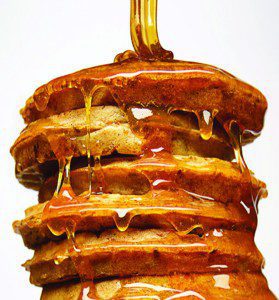By Toni Eatros, MS, Dipl Ac, AP
 Do you know what is in the syrup you are putting on your pancakes? Is there any maple in the pancake syrup you are using in the morning? Is there a difference between real maple syrup and the syrup you are putting on your pancakes?
Do you know what is in the syrup you are putting on your pancakes? Is there any maple in the pancake syrup you are using in the morning? Is there a difference between real maple syrup and the syrup you are putting on your pancakes?
What is real maple syrup?
Real maple syrup contains 100% pure maple syrup. Authentic maple syrup comes from real maple trees that store starch in their trunks in the cold weather. This starch gets converted to sugar when the weather warms up. Holes are drilled into the trunks of the trees and the sap is collected. The sap is then boiled and the water is evaporated. This is then filtered and you now have authentic maple syrup with its characteristic color, flavor and sugar content of about 60%.
40 gallons of sap need to be boiled in order to produce just 1 gallon of syrup. This is why pure maple syrup is so expensive. Some manufacturers add water to the syrup to stretch it and use thickening agents such as cellulose gum and add high fructose corn syrup to sweeten the diluted product.
Is the color important?
In general, the darker the syrup the heartier the flavor. The color of the maple syrup does not denote the quality of the syrup, only the flavor. The color determines when the tree was tapped. The first sap is lighter and not as strong tasting as the darker syrup which comes out of the tree later. There are good quality dark and light maple syrup and your taste preference should determine which one you purchase.
What does the maple syrup grading system refer to?
Grade A light amber does not really mean anything regarding the quality or nutrition of the maple syrup. These grades simply refer to the color of the syrup, and thus, its flavor. There are no laws regulating this name. According the folks at the Kitchn.com, grade B maple syrup is their favorite. Grade B syrup is the dark, thick syrup with a strong flavor and caramel undertones. It is also known as cooking syrup and is used more often for cooking and baking rather than on top of pancakes. Usually less grade B syrup can be used to satisfy palates at the breakfast table, thereby, decreasing the amount of sugar consumed.
What is Pancake Syrup?
One bottle of syrup in 3 or 4 on store shelves are authentic maple syrup. The others are considered to be pancake syrup. Pancake syrup is similar to liquid candy. This pancake syrup is loaded with chemical flavorings, colorings, and preservatives to make it taste like real maple syrup. The ingredient list on pancake syrup includes corn syrup, high fructose corn syrup, water, cellulose gum, caramel color, salt, natural and artificial flavors, sodium hexametaphosphate, sodium benzoate and sorbic acid (preservatives). You will notice there is no maple syrup anywhere in this product. Caramel coloring contains 4-MEI (4-methylimidazole) which is a known carcinogen. Although there are not high levels of 4-MEI in caramel coloring, eaten frequently over time these levels can certainly add up. Real maple syrup is, on average, about $0.90 more per serving than the pancake syrup. However, the cost on your health of putting known carcinogens and other chemicals into your body over time, will be way higher.
Will maple syrup spoil?
Yes, maple syrup once opened, will spoil. It should be put in the refrigerator or freezer once opened and always kept as cold as possible. The shelf life will typically be six months to one year. Maple syrup should not be stored in the pantry as mold can grow on the top of the syrup. You can store maple syrup in the freezer almost indefinitely. It will not freeze completely, but you want it to come to room temperature before using.
Are There any Health Benefits to Real Maple Syrup?
– Boosts the immune system.
– It is rich in antioxidants.
– A natural anti-ager: Repairs environmental & free radical damage of the skin.
– Contains a higher concentration of minerals and antioxidants, yet fewer calories than honey.
– Helps to maintain a healthy heart.
– Aids in maintaining male reproductive health.
– It is less likely to cause indigestion, gas and bloating, compared to processed sweeteners.
“Everything the tree filters out from Mother Nature and all of the good minerals, antioxidants, and everything it is doing for the food for the tree, stays in the sugar,” explains Helen Thomas of the New York State Maple Association. “[Sap] has complex components that are things we also need to stay healthy, just like the trees.”
Before buying, be sure the food label lists “pure” maple syrup as the only ingredient. Also, check that the product is from a single source. A farm’s label will ensure you have an artisan product and not a blended syrup.
As with everything, moderation is key. But, if you are craving something sweet, maple syrup will satisfy that craving while providing a variety of health benefits. Try using maple syrup as a sweetener for coffee, tea and lemonades. Add it to roasted autumn veggies like acorn or butternut squash, frozen organic berries, breakfast oatmeal or hot cereal, soups, salmon, chicken, ham, pulled pork, or roast turkey. It is a perfect substitute for honey in salad dressings.
For more lifestyle and nutrition tips, visit our featured articles page at my website www.acupuncturesolutionsonline.com/featured-articles.
239-260-4566
www.AcupunctureSolutionsOnline.com








